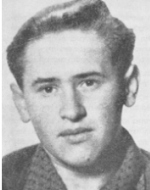Yitzhak, the son of Rosa and Feibel, was born on the 12th of Elul 5626 in Krakow, Poland, and grew up in his hometown Krakow, the third largest city in Poland, was one of the most important Jewish spiritual and cultural centers in Europe. The second was inhabited by about 60,000 Jews, and when the Germans invaded Poland, many Jews fled to the East, and the city was conquered on September 6, 1939. The city of Krakow was declared the capital of the Generalgouvernement In May 1940, the Jews of Krakow were deported to surrounding towns, and by March 1941 some 40,000 Jews were deported A ghetto was set up in the city where some 18,000 Jews were rounded up, many of whom were forced to work in factories set up by the Germans, and deportations to extermination camps began in June 1942. Thousands of ghetto Jews were deported to the Belzec extermination camp, and many others were shot in the streets during the deportation. The ghetto was divided into two parts: those who were fit for work were transferred to the Plaszow camp, and the most incompetent Jews were shot to death in the streets of the city, and the last inhabitants of the Krakow ghetto were sent to Auschwitz where they were murdered in the gas chambers. Shortly after the end of the war, Yitzhak arrived in Italy, and on June 19, 1946, he boarded the port of Savannah on the illegal immigrant ship Josiah Wedgwood. The ship, which was organized by the Mossad Le’Aliyah Bet of the Haganah, carried 1,257 Ma’apilim from 14 countries, including survivors, members of youth movements and former partisans. The British spotted the ship at sea, pinned down a destroyer and landed soldiers on board. The immigrants raised an English banner reading: “We survived Hitler, death is no stranger to us, nothing will alienate us from the homeland of the Jews. The British did not fire, but accompanied the ship until it reached the port of Haifa, eight days after its departure. In Haifa, the immigrants were removed and taken to the Atlit detention camp. Yitzhak and his comrades from Hashomer Hatzair were released from the Atlit camp after two weeks. They joined the nucleus in the name of Tosia Altman – a group that settled temporarily in Kibbutz Ein Hamifratz. With the outbreak of the War of Independence, following the United Nations General Assembly resolution of November 1947 on the Partition Plan, the nucleus was sent as reinforcements to Kibbutz Dan in the Upper Eastern Galilee. Kibbutz Dan, one of the “Homa and Migdal” settlements in the northern Hula Valley, was situated on one of the ancient roads that connected Syria to the Land of Israel. Its strategic location made it an outpost in the War of Independence (and even years later). From the beginning of the war, his older comrades were recruited to the Haganah and later to the IDF’s territorial defense, and Yitzhak took part in the military training, and quickly assumed the burden of security, In the early hours of the morning, a heavy attack began on Kibbutz Dan from the direction of Tel al-Qadi (now Tel Dan), and the kibbutz was not fortified and lacked communication channels. His friends took him to the first aid point, but he died of blood loss, and he was twenty-two years old when he died. Kibbutz Dan was the first victim of the kibbutz during the War of Independence, and the last survivor of the Holocaust is the last survivor of the Holocaust, who survived the last vestige of their nuclear family (parents, brothers, sisters, sons and daughters). Or in concentration and extermination camps and / or in flight and hiding in territories occupied by the Nazis and / or fighting alongside members of the undergroundOr partisans in the Nazi-occupied territories who immigrated to Israel during or after World War II, wore uniforms and fell in the Israeli army.
